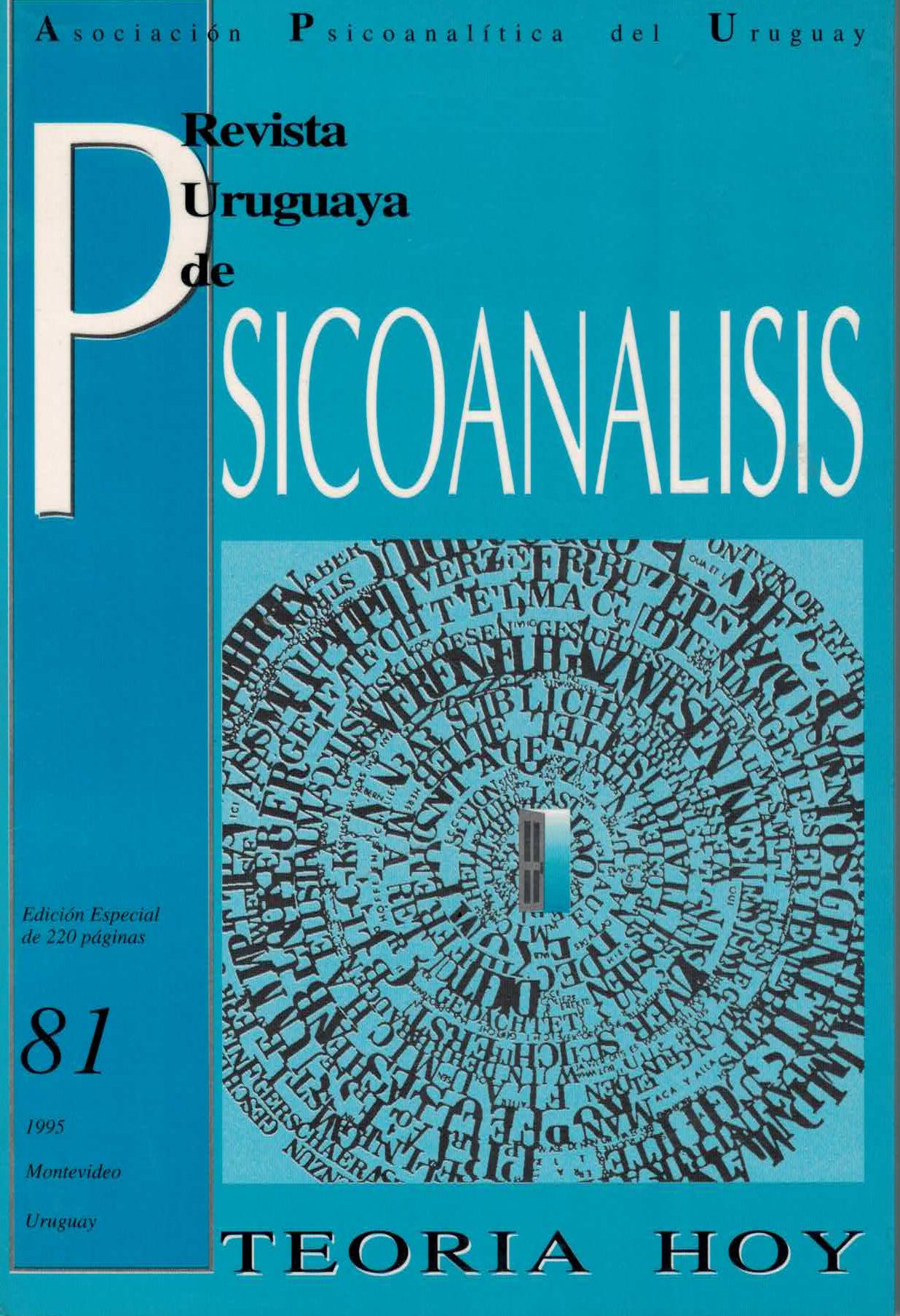The identifications; crossroads quote, dating crossroads
Keywords:
Edipo, identificación primaria, identificación secundaria, aparato psíquico, otro, estadio del espejo, material clínicoAbstract
Clinical facts and theoretical notions as described by different authors belonging in different schools of psychoanalysis are the guidelines along which I express my own reflections on identifications. A vast, complex, and inexhaustible issue having an
enigmatic nature. Our clinical work, our reflections, our theories, they all re-turn, they keep repeating themselves and gaining new meanings, they enter into a feed—back process, are imbricated in new crossroads, and give way to new approaches.
Since the mythic origin of the subject, the primary and secondary identifications are interwoven and resignified in a process framed by the oedipal structure. Meetings (and failed meetings) flow towards a crossroad where wish, love, loss, absence, death, pain,
and mourning are present. A crossroad which involves the infans and the Other, the subject and his neighbor, the other. This is a convergence of quotations, of features —the unique feature of the neighbor, which the subject appropriates, shifted from the object and condensed into the subject— which create an original meaning. The metaphor and the metonymy, origin of a process which is both a creation and a creator. Integration of the difference which gives origin —upon its occurrence— to a new difference. A game of the significant(s). (Narcissistic, mirror) imaginary identifications —which contribute to keeping erect the illusion of the phallus— and symbolic identifications (whose access is granted by repression and symbolic castration). Rather than to a chronological succession, they correspond to an ordering that was structured in logical times. Both the primary and the secondary identifications are solidarily molded into a (not exclusively) symbolic matrix which pre—figures and organizes the mirror, which precedes the birth of the child and awaits for him.
The mother’s wish creates an image which would not be limited to her child’s being, to his existence independently of hers, but would rather have already been attributed the masculine or feminine sex. This is the image the child will find in his mother’s glance,
transmitting her wish. An image which knots the future actual body with the (symbolic) name of the child, already chosen before his birth. The real, the imaginary and the symbolic, all interwoven in this matrix which is anticipating the mirror.
His cry, the spokesman of the body transfixed with pain, links him to the language. A body which becomes both a text and a texture. A body linked to a name which, even before his birth, inscribes the child in a discourse, grants him a filiation, places him
symbolically within a genealogy.
The phantasy, a turning round upon the subject’s own self and a reversal into the opposite, the transitional object, the objecta, they ah play also a role in the identifications which give origin to the subject in his alterity —even if struggling in a crossroad, an existing and discriminated being, but also provided with a sexual identity.
Downloads
References
Casas de Pereda M. Sobre las identificaciones. Un desarrollo freudiano. Temas de psicoanálisis. 1986;(7):89—97.
Casas de Pereda M. Estructuración psíquica. Rev. Urug Psicoanálisis 1992;76:83—94.
Casas de Pereda M. La neurosis hoy. En: Jornadas Científicas Abiertas. AsociaciónPsicoanalítica del Uruguay, VIII. Montevideo; set. 1993:25—38.
Castoriadis-Aulagnier P. Observaciones sobre la estructura psicótica. 1963.
En: Varios autores. Psicoanálisis de la psicosis. Carpeta de Psicoanálisis 1. Buenos Aires, Letra Viva, 1978.
Freud S. Proyecto de psicología. 1950 (1895). Obras Completas. Volumen 1. Buenos Aires, Amorrortu editores, 1982.
Freud S. Tres ensayos de teoría sexual. 1905. Obras Completas. Volumen 7. Buenos Aires, Amorrortu editores, 1978.
Freud S. Pulsiones y destinos de pulsión. 1915. Obras Completas. Volumen 14. Buenos Aires, Amorrortu editores, 1979.
Freud S. El yo y el ello. 1923. Obras Completas. Volumen 19. Buenos Aires Amorrortu editores, 1979.
García J. El narcisismo en las neurosis. En: Jornadas Científicas Abiertas. Asociación Psicoanalítica del Uruguay, VIII. Montevideo; set. 1993:295—303.
Gil D. El yo y la identificación primaria. Temas de psicoanálisis. 1988; 10:39—46.
Julien P. El retorno a Freud de Jacques Lacan. La aplicación al espejo. 1985. México, SITESA, 1992.
Klein, M. Algunas conclusiones teóricas sobre la vida emocional del bebé. 1952. En: Desarrollos en psicoanálisis. Buenos Aires, Ediciones Hormé S. A. E., 1971.
Klein M. Sobre la identificación. 1955. Obras Completas. Volumen 1V. Nuevas direcciones en psicoanálisis. Buenos Aires, Editorial Paidós, 1965.
Lacan J. La agresividad en psicoanálisis. 1948. En: Escritos II. México, Siglo Veintiuno Editores S. A., 1975.
Lacan J. Las formaciones del inconciente. 1957—1958. Transcripción de Pontalis, J. B. Buenos Aires, Ediciones Nueva Visión, 1977.
Martínez de Bagattini C. En los límites entre la perversión y la neurosis. Dos mundos en el mundo. En: Jornadas Científicas Abiertas. Asociación Psicoanalítica del Uruguay, VIII. Montevideo; set. 1993; p. 329—338.
McDougall J. Hermafrodita y la masturbación. 1973. En: Alegato por cierta anormalidad. Barcelona, Ediciones Petrel, S. A., 1982.
Nasio JD. El magnífico niño del psicoanálisis. Barcelona, Editorial Gedisa S. A., 1986.
Pérez de PLA. E. Genealogía e historización en la psicosis infantil. 1991. Rev. Urug Psicoanálisis 1993;77:9—22.
Pessoa F. Libro del desasosiego. Barcelona, Seix Barral, 1991.
Sapriza S. Lo transgeneracional y las identificaciones alienantes. Rev. Urug Psicoanálisis 1993;77:57—71.
Vallejo A. Topología de J. Lacan —del Narcisismo-. Buenos Aires, Helguero Editores, 1979.
Winnicott DW. Realidad y juego. 1971. Barcelona, Gedisa, 1979.



 This work is licensed under a
This work is licensed under a 